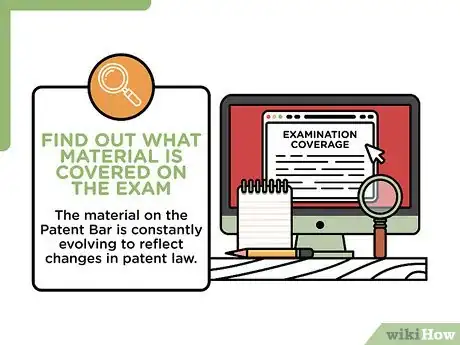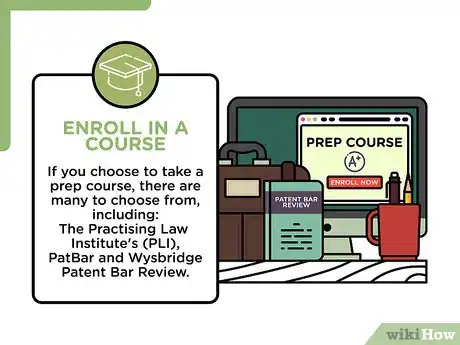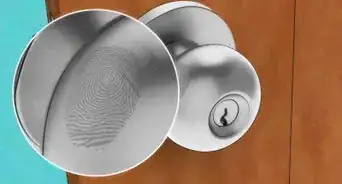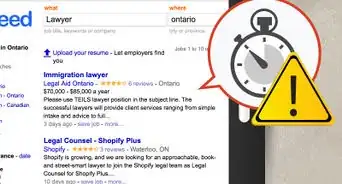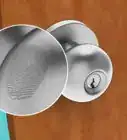This article was co-authored by Clinton M. Sandvick, JD, PhD. Clinton M. Sandvick worked as a civil litigator in California for over 7 years. He received his JD from the University of Wisconsin-Madison in 1998 and his PhD in American History from the University of Oregon in 2013.
There are 8 references cited in this article, which can be found at the bottom of the page.
This article has been viewed 106,881 times.
To become a patent lawyer in the U.S., one must register to practice law with the United States Patent and Trademark Office (USPTO). To register to practice law with the USPTO, a person must meet general requirements, such as possessing the requisite scientific and technical training, as well as a strong moral character. In addition, he must pass the Patent Bar, a multiple-choice exam administered by both the USPTO and the commercial test delivery provider, Prometric.
Steps
Meeting General Requirements
-
1Have US citizenship or reside legally in the US. To register with the USPTO, one must be either a U.S. citizen or reside legally in the U.S.[1]
- If you are not a U.S. citizen, you will need to present proof that you reside legally and have permission to work in the U.S. This includes a copy of both sides of your work permit and all documentation submitted to and received from USCIS and the Department of Labor.
-
2Complete an undergraduate degree in a scientific field. To register with the USPTO, one must possess the necessary scientific and technical training. This can be established in one of three ways. The most straightforward way to meet this requirement is to present an official transcript (with a university stamp or seal) showing that you were awarded a Bachelor's degree in one of the following subjects by an accredited U.S. college or university, or that you were awarded the equivalent to a Bachelor's degree by a foreign university in one of the following subjects:[2]
- Biology
- Biochemistry
- Botany
- Computer Science: must be accredited by the Computing Sciences Accreditation Board (CSAB) or by the Accreditation Board for Engineering and Technology (ABET)
- Electronics Technology
- Food Technology
- General Chemistry
- Marine Technology
- Microbiology
- Molecular Biology
- Organic Chemistry
- Pharmacology
- Physics
- Textile Technology
- Engineering: general, aeronautical, agricultural, biomedical, ceramic, chemical, civil, computer, electrical, electrochemical, engineering physics, geological, industrial, mechanical, metallurgical, mining, nuclear, petroleum
Advertisement -
3Complete scientific coursework equivalent to an undergraduate degree in a scientific field. If you do not have the required undergraduate degree, you can meet the scientific and technical training requirement by submitting official transcripts that show the completion of an undergraduate degree and one of the following four types of coursework:[3]
- 24 semester hours in physics (only physics courses for physics majors will be accepted)
- 32 semester hours in a combination consisting of the following: 8 semester hours of chemistry or 8 semester hours of physics, and 24 semester hours in biology, botany, microbiology, or molecular biology.
- 30 semester hours in chemistry (only chemistry courses for chemistry majors will be accepted)
- 40 semester hours in a combination consisting of the following: 8 semester hours of chemistry or 8 semester hours of physics, and 32 semester hours of chemistry, physics, biology, botany, microbiology, molecular biology, or engineering.
-
4Pass the Fundamentals of Engineerings (FE) test. If you do not have an undergraduate degree or equivalent coursework that meets the scientific and technical training requirement, you can still meet this requirement by presenting evidence that you passed the Fundamentals of Engineerings (FE) test.[4]
- If you wish to take the FE, contact the secretary of the State Board of Engineering Examiners in your state or jurisdiction.
- The USPTO requires that you submit official results showing that you passed the FE test, as well as an official transcript showing the award of a Bachelor's degree.
-
5Meet good moral character requirements. To register with the USPTO, you must show that you have good moral character. You will be found ineligible if:[5]
- You have been convicted of a felony, or a crime involving moral turpitude or breach of trust, unless more than two years have passed since you completed your sentence, deferred adjudication, probation or parole and you can show proof of rehabilitation.
- You have been disbarred from the practice of law or other profession, or resigned a professional license in lieu of a disciplinary proceeding, unless more than five years have passed since the date of disbarment or resignation.
- You have already been refused registration for failure to demonstrate good moral character unless more than two years have passed.
-
6Graduate from law school. To register with the USPTO as a patent lawyer, one must already be an attorney. To become an attorney, one must be licensed to practice law by the Bar Association in his jurisdiction. In general, a person must obtain a Juris Doctor (JD) degree from an American Bar Association (ABA) approved law school in order to practice law.
- To apply to law school, you will need to register with the Law School Admission Council (LSAC), take the Law School Admission Test (LSAT), gather your official transcripts from your undergraduate university, prepare a personal statement and apply to law schools online through the LSAC website.[6]
- The USPTO does not require that an applicant complete any particular coursework during law school. However, once you begin practicing patent law, it will be helpful to have taken courses in Intellectual Property, Trademark Law and Patent Law and have participated in any clinical programs that give you practical experience in the field of intellectual property.
- Not all states require that a person have completed law school in order to practice law. In Virginia, Vermont, Washington and California, a person is eligible to become a lawyer if he has completed a legal apprenticeship and passes the state Bar exam. [7]
- If you are not an attorney, you can still register with the USPTO as a "patent agent" as long as you meet the technical and moral character requirements and pass the Patent Bar.
-
7Pass your state Bar exam. Almost all jurisdictions require that a person pass a Bar exam before he can become licensed to practice law. The only exception is Wisconsin, which grants a "diploma privilege" to graduates of the University of Wisconsin Law School and Marquette University Law School, allowing them to become licensed in Wisconsin without passing the Bar exam.
- The Bar exam is administered by individual states and jurisdictions within the U.S. To find out the contents of the exam and review the criteria for eligibility, visit the website of the Bar Association in your particular jurisdiction.
- Generally, the Bar exam consists of two days of testing. The first day is devoted to a standardized multiple-choice test known as the Multistate Bar Examination (MBE). The second day is typically comprised of essay questions based on areas of law specific to that jurisdiction.
- A separate multiple choice exam on ethical standards known as the Multistate Professional Responsibility Exam (MPRE) is also required by most jurisdictions. This exam can usually be taken earlier than the Bar exam.
Passing the Patent Bar
-
1Apply to register with the USPTO. To take the Patent Bar, you must first apply to register with the Office of Enrollment and Discipline (OED) at the USPTO. You will need to complete the "Application for Registration to Practice before the United States Patent and Trademark Office" (Form PTO-158) and send it to Mailstop OED, U.S. Patent and Trademark Office, P.O. Box 1450, Alexandria, Virginia 22313-1450, along with the following documents and fees:[8]
- Evidence of scientific and technical training, such as official transcripts showing a Bachelor's degree is an accepted scientific field or the completion of scientific coursework equivalent to an undergraduate degree accompanied by course descriptions.
- If you are not a U.S. citizen, provide evidence that you reside legally in the U.S., including a copy of both sides of your work permit and all documentation submitted to and received from USCIS and the Department of Labor.
- If you have a criminal history, provide a full explanation in writing of your arrests and convictions, a complete copy of all court records regarding each incident and any other documents requested in the section of the application that asks about your criminal history.
- A cashier's or certified check, Treasury note, or United States Postal Service money order made payable to the Director of the United States Patent and Trademark Office for $240 (includes the application and registration fee). Note that if you have a criminal background a higher fee is required.
-
2Wait to receive your admission letter. Once you have submitted your application to register with the OED, you will receive an admission letter with further instructions on the examination process. You will also receive a USPTO identification number. You will need to use this number in all future correspondence with the OED.[9]
- If you plan to register for the exam with the commercial test delivery provider, Prometric, you will need to provide your USPTO ID number during the exam registration process.
- The admission letter will state the exact date by which you must take the exam (90 days from the date on which the letter was sent).
-
3Register for the exam. The Patent Bar is administered by both the USPTO and a commercial test delivery provider, Prometric. The USPTO exam is given on paper, while the Prometric exam is computer-based. The USPTO exam is only offered once per fiscal year at the USPTO office in Alexandria, Virginia, while the Prometric exam is offered in a variety of locations at various times throughout the year.[10]
- To find out the date of the next USPTO exam, visit the USPTO website. To register for the exam, the process is identical to applying to register with the OED. The only differences are that you must register by the deadline required for your exam, include an additional fee of $450 and check the box in Line 8b of the application to indicate you wish to register for the USPTO exam.
- To register for the Prometric administered examination, first apply for registration with the USPTO. Then, contact Prometric to schedule the exam by calling 800-479-6369 or visiting the company's website (http://www.prometric.com) and indicate you wish to take the exam sponsored by the USPTO. You will need to provide an eligibility ID provided to you by the OED in your admission letter.[11]
-
4Find out what material is covered on the exam. The material on the Patent Bar is constantly evolving to reflect changes in patent law. For this reason, it is critical that you find out what material will be covered on your exam.[12]
- Check the USPTO website for the source materials that will be tested on your exam. [13]
- Be careful about relying on old practice tests or outlines to study for the Patent Bar. The last time the source materials for the exam changed was in 2014, which means any materials before that date may not be reliable.
-
5Devise a study plan. To prepare for the Patent Bar, you can either study on your own or enroll in a course.[14]
- If you choose to study on your own, you will save the money it would cost to enroll in a course. All of the material tested on the Patent Bar is publicly available in the Manual of Patent Examining Procedure (MPEP) and you can review it on your own. However, the MPEP is several thousands of pages long and therefore very overwhelming to a person who is approaching it for the first time. To make matters worse, some sections of the MPEP have not been updated to reflect changes in law and can mislead those preparing for the exam. For this reason, studying on your own can be very challenging. The first-time pass rate among those who attempt this method is only around 15%.
- The alternative is to enroll in a reputable commercial exam prep course. The advantage to this approach is that you will be given study guides that highlight the most important information that will be tested on your exam and thousands of reliable practice questions that have been updated to reflect the test you will take.
-
6Enroll in a course. If you choose to take a prep course, there are many to choose from, including:
- The Practising Law Institute's (PLI) Patent Bar Review is the most commonly taken prep course. The course will provide you with a study guide that outlines all of the tested materials and access to a bank of practice questions that help you identify your strong and weak points. The test-takers who enroll in this course pass the exam on their first attempt 88% of the time. The disadvantage is the price, which is almost $2800 for non-students and almost $1900 for students.
- PatBar Patent Review course is a cheaper alternative to PLI's Patent Bar Review. It costs between $600 and $900, depending on whether a discount is offered. Like PLI's course, PatBar also provides its students with concise and easily digestible outlines and practice questions that reflect the information on the exam. However, the PatBar website does not disclose the pass rate of its students so that is difficult to know whether it is as effective as PLI's Patent Bar Review.[15]
- Wysebridge Patent Bar Review is an even cheaper alternative, costing only $349. It aims to simplify the process of studying for the Patent Bar by targeting only the material you most need to know and boasts a pass rate of 83%, which it claims is higher than any other course offering a similar price. The course is conducted entirely online.[16]
-
7Take the exam. You must take your exam within 90 days of having received your admission letter from the OED.[17]
- If you are taking the Prometric administered exam, you must pay an examination administration fee of $160 before you get to the test center. If you are taking the USPTO administered exam, you will have paid the examination fee when you applied to register with the USPTO.
- Arrive at least 30 minutes before the exam is scheduled to begin.
- Bring a current, valid state or federal government issued ID, such as a driver's license or passport, to the test center. The name on your ID must match the name your name as it appeared in your application to register with the OED.
- Do not bring reference materials or any notes or scratch paper with you to the test center. Reference materials will be given to you at the test center.
- If you are taking the USPTO administered exam, bring at least two #2 pencils with you to the test center.
-
8Find out whether you passed the exam. Results of the examination will be mailed to you soon after the date on which you took the examination.[18]
- If you take the computer examination administered by Prometric, you will receive unofficial results on the computer at the end of exam. Your official results will arrive by mail.
- If you take the USPTO administered examination, you will receive your results by mail.
- If you pass, you will receive instructions for completing the registration process so that you are fully licensed to practice patent law.
References
- ↑ http://www.uspto.gov/sites/default/files/OED_GRB.pdf
- ↑ http://www.uspto.gov/sites/default/files/OED_GRB.pdf
- ↑ http://www.uspto.gov/sites/default/files/OED_GRB.pdf
- ↑ http://www.uspto.gov/sites/default/files/OED_GRB.pdf
- ↑ http://www.uspto.gov/sites/default/files/OED_GRB.pdf
- ↑ http://www.lsac.org/jd/diversity-in-law-school/racial-ethnic-minority-applicants/minorities-in-legal-education-applying-to-ls
- ↑ http://www.slate.com/blogs/business_insider/2014/08/02/states_that_allow_bar_exams_without_law_degrees_require_apprenticeships.html
- ↑ http://www.uspto.gov/sites/default/files/OED_GRB.pdf
- ↑ http://www.uspto.gov/sites/default/files/OED_GRB.pdf
- ↑ http://www.uspto.gov/sites/default/files/OED_GRB.pdf
- ↑ https://www.prometric.com/en-us/clients/uspto/Pages/landing.aspx
- ↑ http://bciptf.org/?p=1164
- ↑ http://www.uspto.gov/sites/default/files/registrationexamsourcematerial.pdf
- ↑ http://bciptf.org/?p=1164
- ↑ http://patbar.com
- ↑ http://www.wysebridge.com
- ↑ http://www.uspto.gov/sites/default/files/OED_GRB.pdf
- ↑ http://www.uspto.gov/sites/default/files/OED_GRB.pdf
About This Article
To become a patent lawyer in the United States, you must be a U.S. citizen or legally reside in the U.S. You will also need to complete an undergraduate degree in a scientific field such as biology, engineering, or chemistry. Take and pass the FE test, or the Fundamentals of Engineerings test. You must also attend law school and be licensed to practice law in your jurisdiction. When you’re ready to become a patent attorney, you must register with the United States Patent and Trademark Office and pass the patent bar. For more tips from our reviewer on passing the patent bar, read on!










